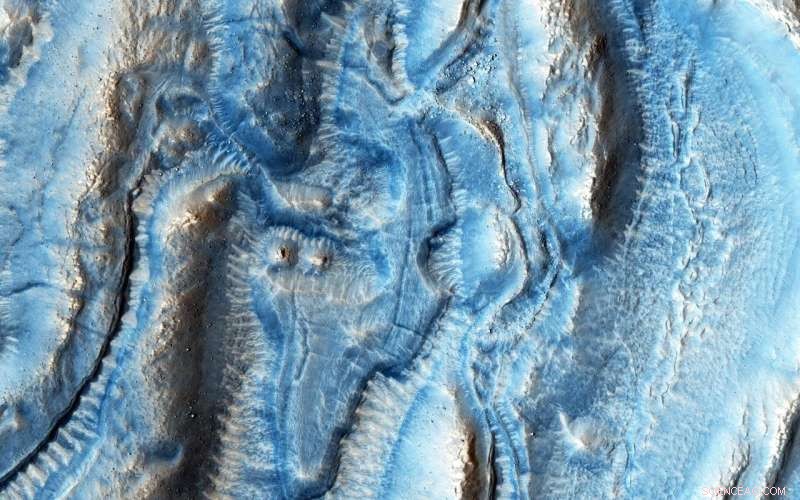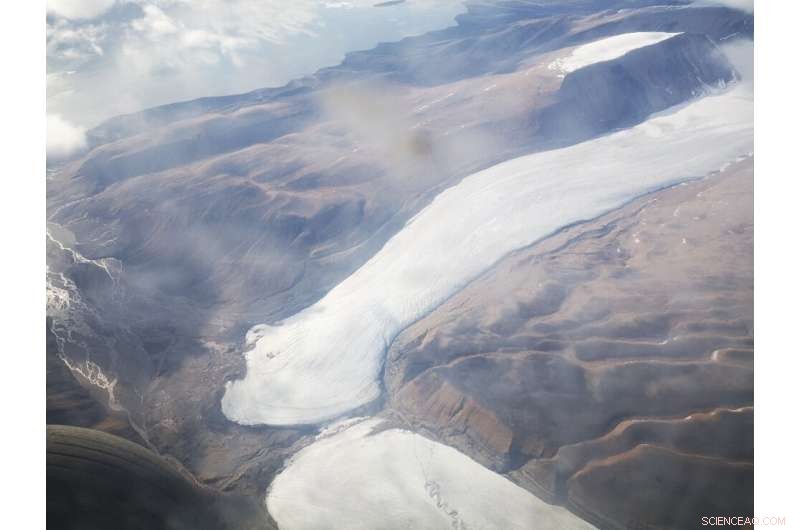
På grund av Mars unika förhållanden flödade dess gamla glaciärer troligen mycket långsamt, enligt en ny studie i Geophysical Research Letters. En rad isegenskaper finns på den röda planeten idag. Kredit:NASA/JPL-CalTech/University of Arizona
Glaciärernas tyngd och malande rörelse har skurit in distinkta dalar och fjordar i jordens yta. Eftersom Mars saknar liknande landskap, trodde forskarna att gamla ismassor på den röda planeten måste ha frusit fast till marken. Ny forskning tyder på att de inte satt fast på plats, utan bara rörde sig väldigt långsamt.
Rörelse är en del av definitionen av en glaciär. På jorden samlas smältvatten under glaciärer och inlandsisar, som smörjer nedförsbacken av dessa isfloder. Den nya studien modellerade hur Mars låga gravitation skulle påverka återkopplingen mellan hur snabbt en inlandsis glider och hur vatten dräneras under isen, och hitta underiskanaler skulle sannolikt bildas och bestå. Snabb vattendränering skulle öka friktionen i gränsytan mellan sten och is.
Detta innebär att inlandsisar på Mars sannolikt flyttade och eroderade marken under dem, i extremt långsamma hastigheter, även när vatten samlades under isen, sa författarna. Den nya studien publicerades i Geophysical Research Letters .
"Is är otroligt icke-linjär. Återkopplingarna som relaterar till glacial rörelse, glacial dränering och glacial erosion skulle resultera i fundamentalt olika landskap relaterade till närvaron av vatten under tidigare inlandsisar på jorden och Mars", säger Anna Grau Galofre, en planetforskare vid Laboratoire de Planétologie et Géosciences (LPG/CNRS/ Nantes Université/ Le Mans Université/ Universtié d'Angers) och huvudförfattaren till den nya studien, utförd medan hon var postdoc vid Arizona State University.
Även om Mars inte har de uppenbara U-formade dalarna som markerar jordens glaciala landskap, sa Grau Galofre, har forskare funnit andra geologiska spår som tyder på glaciärliknande ismassor i Mars förflutna, inklusive grusåsar som kallas eskers och potentiella subglaciala kanaler.

Glaciala landskap på Axel Heiberg Island (Kanadensiska arktiska skärgården) som visar typiska (glaciärer) och atypiska (subglaciala kanaler, längst ner till höger) glaciala landskap. Kredit:A. Grau Galofre
"Whereas on Earth you would get drumlins, lineations, scouring marks and moraines, on Mars you would tend to get channels and esker ridges under an ice sheet of exactly the same characteristics," Grau Galofre said.
Grau Galofre and her co-authors modeled the dynamics of two equivalent ice sheets on Earth and Mars with the same thickness, temperature and subglacial water availability. They adapted the existing physical framework that describes the drainage of water accumulated under Earth's ice sheets, coupled with ice motion dynamics, to model Martian conditions and learn whether the subglacial drainage would evolve toward efficient or inefficient drainage configurations, and what effect this configuration would have on glacial sliding velocity and erosion.
"Going from an early Mars with presence of surface liquid water, extensive ice sheets and volcanism into the global cryosphere that Mars currently is, the interaction between ice masses and basal water must have occurred at some point," Grau Galofre said. "It is just very hard to believe that throughout 4 billion years of planetary history, Mars never developed the conditions to grow ice sheets with presence of subglacial water, since it is a planet with extensive water inventory, large topographic variations, presence of both liquid and frozen water, volcanism, [and is] situated further from the Sun than Earth."
The findings of this modeling effort demonstrate how glacial ice masses would drain their basal meltwater much more efficiently on Mars than Earth, largely preventing any lubrication of the base of ice sheets that would lead to fast sliding rates and enhanced glacial erosion. Indeed, typical lineated landforms found on Earth would not have time to develop on Mars, according to this study.
The work also has implications for the survival of possible ancient life forms on Mars, according to the authors. An ice sheet could provide a steady supply of water, protection and stability to any subglacial water bodies like lakes, shelter from solar radiation in the absence of a magnetic field, and insulation against extreme temperature variations. + Utforska vidare